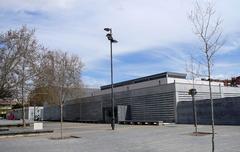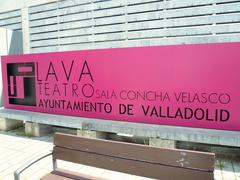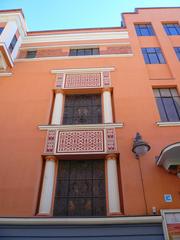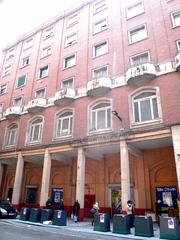
Archivo de la Real Chancillería de Valladolid: Visiting Hours, Tickets, and Historical Significance Guide
Date: 04/07/2025
Introduction
The Archivo de la Real Chancillería de Valladolid (ARCHV) is one of Spain’s most significant historical archives, located in the heart of Valladolid. Established in 1489 by the Catholic Monarchs Ferdinand II of Aragon and Isabella I of Castile, the archive was created to safeguard the legal, judicial, and administrative documentation of the Real Audiencia y Chancillería de Valladolid—the supreme court for the Crown of Castile north of the River Tagus. Today, the ARCHV preserves a vast collection comprising nearly 17 kilometers of documents, some dating back to the 8th century.
The archive is not only a vital research center for legal, genealogical, and social history but also a vibrant cultural institution. It offers accessible facilities, free entry, guided tours, exhibitions, and digital resources, making it an essential stop for researchers, genealogists, students, and travelers interested in Valladolid historical sites and the evolution of Spanish justice. Extensive online access via the PARES portal further broadens its reach to a global audience.
This guide provides detailed information on the archive’s history, collections, visiting hours, ticketing, accessibility, services, and nearby cultural attractions, helping you plan a meaningful and enriching visit. For official updates, consult the Ministry of Culture and Sport’s archive page and the PARES digital archive portal.
Table of Contents
- Origins and Historical Development
- Key Collections and Their Significance
- Visiting Information: Hours, Tickets, and Accessibility
- Guided Tours, Cultural and Educational Activities
- Digital Access and Research Support
- Nearby Attractions
- Frequently Asked Questions (FAQ)
- Visitor Tips
- Conclusion and Further Resources
Origins and Historical Development
Foundation and Early History (15th–16th Century)
The ARCHV’s foundation dates to 1489, following the Catholic Monarchs’ reforms to centralize and safeguard judicial records. The archive was housed within the Real Audiencia y Chancillería de Valladolid, which served as the highest court for northern Castile. Early archival practices involved storing documents in dedicated cabinets managed by the court’s scribes (Wikipedia).
Although initially less structured, the archive gradually developed systematic organization throughout the 16th century, laying the groundwork for what would become one of Europe’s preeminent judicial archives.
The Real Audiencia y Chancillería de Valladolid (1371–1834)
This supreme court generated an extensive documentary legacy, including civil and criminal case files, judgments, privileges, and correspondence. The records reflect the complex social, economic, and legal dynamics of Spain’s historical heartland, making the archive invaluable for understanding the country’s judicial history.
Transformation and Modernization (19th–20th Century)
With the dissolution of the Real Audiencia in 1834, its duties and documents passed to the Audiencia Territorial de Valladolid, which continued to generate and preserve legal records. In 1906, the archive’s stewardship shifted to professional archivists, marking a new era of conservation and public service. Continued modernization saw the expansion of facilities and integration into the national network of state archives (Scribd).
Key Collections and Their Significance
Judicial and Administrative Holdings
- Civil and Criminal Case Files: Spanning centuries, these files provide rare insights into the administration of justice, social relations, and legal reforms.
- Registro de Ejecutorias: Over 187,000 records related to royal enforcement of court judgments, a unique resource for legal and social historians, many accessible via the PARES portal.
- Pleitos de Hidalguía (Nobility Lawsuits): Essential for genealogists, these cases document claims to noble status, often including detailed family trees, testimonies, and local parish records (Genealogía Hispana).
- Administrative and Institutional Documents: Appointments, salaries, official correspondence, and regulations trace the evolution of Spain’s judicial institutions.
- Maps, Plans, Seals, and Manuscripts: Materials of paleographic, legal, and artistic value, providing context for property disputes and institutional history.
Digital Collections
A growing number of documents, especially the pleitos de hidalguía and Registro de Ejecutorias, are digitized and available on the PARES portal, facilitating global research and genealogical inquiry.
Visiting Information: Hours, Tickets, and Accessibility
Location
Address: Plaza de San Pablo, 6, 47002 Valladolid, Spain
The archive is centrally located, a short walk from Valladolid’s main attractions, public transport, and parking facilities.
Visiting Hours
- Monday to Friday: 9:00 AM – 2:00 PM
- Closed: Weekends and public holidays
Hours may vary during holidays or special events; check the official archive page for updates.
Tickets and Admission
- Entry: Free for all visitors. Research appointments are required for access to reading rooms and archival materials.
- Guided Tours: Offered periodically; advance booking recommended, especially for group or English-language tours.
Accessibility
- Step-free entrances, elevators, accessible restrooms, and reserved seating are available.
- Visitors with disabilities are encouraged to contact the archive ahead of their visit for personalized assistance.
Guided Tours, Cultural and Educational Activities
- Guided Tours: Highlight the archive’s history, architecture, and key collections. Available in Spanish and by prior arrangement in English.
- Exhibitions: Thematic displays showcase original manuscripts, legal cases, and special topics such as leprosy history (International Leprosy Association).
- Educational Programs: Workshops for schools and universities, seminars on archival science and paleography, and family-friendly activities.
- Community Events: Open days, heritage festivals, and collaborative programs with local museums and cultural institutions (Archivos Castilla y León).
Digital Access and Research Support
- On-site Services: Spacious, well-equipped reading rooms with computers, microfilm readers, and Wi-Fi. Staff assistance and catalog access provided.
- Document Reproduction: Photocopying and scanning services are available; fees and restrictions may apply.
- Online Resources: Extensive digitized holdings accessible via the PARES portal and the Portal de Archivos de Europa.
- Finding Aids: Online catalogues, research guides, and downloadable educational materials support remote research and pre-visit planning.
Nearby Attractions
Combine your visit to the archive with exploration of other Valladolid historical sites:
- Church of San Pablo
- Valladolid Cathedral
- Plaza Mayor
- National Sculpture Museum
- Casa-Museo de Cervantes
Numerous cafés, restaurants, and hotels are within walking distance, allowing for a full day of cultural discovery.
Frequently Asked Questions (FAQ)
Q: What are the Archivo de la Real Chancillería de Valladolid visiting hours?
A: Monday to Friday, 9:00 AM–2:00 PM; closed weekends and public holidays.
Q: Is there an admission fee or ticket required?
A: Entry is free; research appointments are recommended for access to reading rooms.
Q: Are guided tours available?
A: Yes, guided tours and educational activities are offered; check the archive’s website or contact in advance for availability.
Q: Can I take photographs inside the archive?
A: Photography is generally allowed in public and exhibition areas without flash or tripods. Restrictions may apply in reading rooms.
Q: Is the archive accessible for visitors with disabilities?
A: Yes, with step-free access, elevators, and accessible restrooms.
Q: How can I access digital collections?
A: Many documents are digitized and available through the PARES portal.
Visitor Tips
- ID Required: Bring valid photo identification for archival research.
- Language: Most materials and tours are in Spanish; English assistance is available with advance notice.
- Document Requests: Check the online catalog and contact the archive to request materials before your visit.
- Dress Comfortably: The climate-controlled environment may feel cool; dress in layers.
- Respect Quiet Zones: Maintain silence in reading rooms to support research.
Conclusion and Further Resources
The Archivo de la Real Chancillería de Valladolid is a cornerstone of Castilian and Spanish heritage, offering unparalleled documentation of legal, genealogical, and cultural evolution. With its free admission, central location, and commitment to accessibility and education, the archive welcomes all to explore Spain’s past and enrich their understanding of Valladolid historical sites.
Plan your visit, participate in cultural activities, and take advantage of extensive digital resources to deepen your engagement with Spanish history. For the latest information, consult the official Ministry of Culture archive page and consider downloading the Audiala app for curated guides and updates on historical sites in Valladolid.
References
- Archivo de la Real Chancillería de Valladolid: History, Visiting Hours, Tickets, and Visitor Guide, 2025 (Wikipedia)
- Visiting the Archivo de la Real Chancillería de Valladolid: History, Collections, and Practical Guide for Visitors, 2025 (Scribd)
- Ministerio de Cultura y Deporte – Archivo de la Real Chancillería de Valladolid, 2025 (Ministry of Culture)
- PARES digital archive portal, 2025 (PARES)
- Portal de Archivos de Europa, 2025 (Portal de Archivos de Europa)
- Consulta online los pleitos de hidalguía de la Real Chancillería de Valladolid (Genealogía Hispana)
- Archivo de la Real Chancillería de Valladolid: International Leprosy Association database (International Leprosy Association)
- Archivo de la Real Chancillería de Valladolid: Censo Archivos (Censo Archivos)
- Archivo de la Real Chancillería de Valladolid: Archivos Castilla y León (Archivos Castilla y León)
- Archivo de la Real Chancillería de Valladolid: CVC Cervantes (CVC Cervantes)
- Archivo de la Real Chancillería de Valladolid: Cascanueces Blog (Cascanueces Blog)






